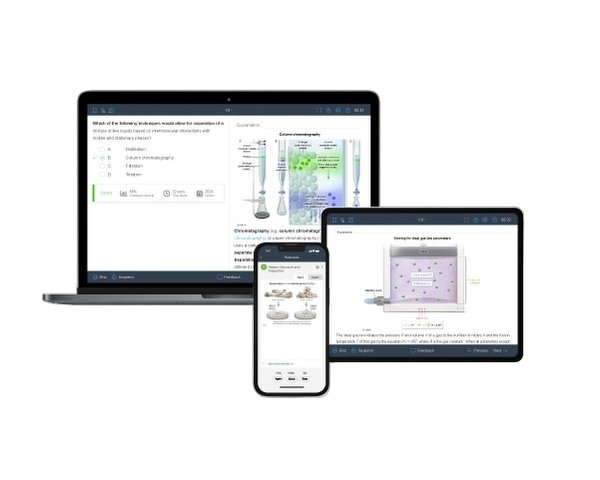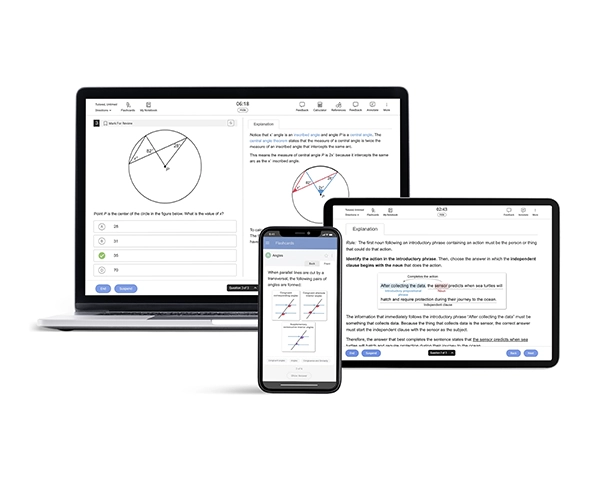Labs are required in many science classes, so mastering the art of writing a lab report is essential for success in AP® Chemistry. Before focusing on the AP Chemistry lab report format, here are a few tips to keep in mind about labs in general:
- Write your lab report immediately after performing the experiment to ensure accuracy and clarity. Keeping the information fresh in your mind is key.
- If your teacher permits, take photos of your experiment before, during, and after to help with accurate descriptions. If photos aren't allowed, make detailed sketches in your lab notebook, especially for complex setups.
- Follow all instructions carefully. If you have any questions about the report, ask your teacher for guidance.
AP Chemistry Lab Report Format
Each teacher may have specific requirements for an AP Chemistry lab report, But here are the general sections that a lab report can contain:
Title
The title of your lab report should be as specific as possible. You can often follow the model of “The Effect of X on Y.” Let's say you conducted an experiment on the growth of potato plants using soils with different pH levels. A recommended title for your report would be "The Effect of Soil pH on the Growth of Potato Plants."
You don't need to provide too many details in the title. That's what the other sections of your report are for. For example, "The Effect of Different Soils with pH Levels of 4, 6, and 8 on Growth in 18 Potato Plants" is too long and detailed. Be concise while still conveying the type of experiment you conducted and what your readers can expect from the overall lab report.
Abstract
Not all teachers will expect an abstract, but this section is a valuable exercise for reading and writing authentic scientific articles. Provide a concise summary – usually under 100 words – of the entire experiment and analysis. Touch upon the subject of the study, state your hypothesis, and summarize the results. Include a concluding statement that highlights the main findings of the experiment.
Introduction/Background
This section of your AP Chemistry lab report should provide the necessary background information to understand your experiment. Introduce the purpose of the experiment so that it is clear why it was conducted.
State your hypothesis or testable statement. Your hypothesis is typically written in an "if/then" format. For example, "If acidic soil is best for plant growth, then potato plants will grow taller when grown in soil with a lower pH." Include the reasoning behind your hypothesis. If you believe that more acidic soil will result in better potato plant growth, explain why. Briefly define any key terms that need to be introduced.
Materials and Methods
This section should list all the materials used and their quantities. For example, light and water would be included in the plant growth experiment.
In addition to the materials list, you will explain each step you took to complete your experiment so that other scientists can reproduce your results. That validates your experiment in the eyes of the scientific community.
Make sure to mention all the controllable, independent, and dependent variables. Use the past tense when describing your materials and methods since this section describes an experiment you have already conducted. For instance, write "the height of each potato plant was measured daily," not "measure the height of each potato plant daily."
Results
The results you obtained during your experiment are presented in this section. They typically will be in the form of tables and/or graphs. Reflect on your experiment and results to determine the most effective way to depict them visually.
When creating tables and graphs, ensure each is clear, easy to follow, and accompanied by a descriptive title.
Consider including averages for experiments with multiple trials. Remember to include units when displaying numerical figures. If your lab report includes a graph, label both the X and Y axes appropriately and include a key or legend if necessary. If your experiment involved statistical analyses or calculations, include them as well.
The statistical analyses, graphing tasks, and production of tabular data required for your report are directly related to the science practices assessed in the AP Chemistry exam, as outlined in our How to Study for AP Chemistry article. Therefore, you must invest in learning and mastering the skill set of visually representing scientific data and using statistics-based reasoning.
Results contradicting your hypothesis are just as valuable and do not indicate that your experiment has failed or that you should falsify data. It is of the utmost importance to always accurately represent the actual data obtained in the experiment.

Analysis and Discussion
This will be the main content of your AP Chemistry lab report. You will present an analysis2 of the results you obtained in your experiment and whether they "support" or "contradict" your hypothesis. It is important to use this in relation to your results rather than saying "prove" or "disprove." Remember, results that do not support your hypothesis are valid. This section gives you an opportunity to explain why you think these unexpected results occurred.
You can also discuss any limitations, materials, or methods and suggest improvements if the experiment were to be conducted again. You also may propose related investigations that could be performed based on the results of your experiment. For example, you might suggest testing different soil brands with the same pH to observe potato plant growth once you determine the ideal pH level.
Your goal should be to clearly explain the significance of your results and their implications on the information discussed in your introduction/background section. When making statements about your experiment, be sure to refer to your results, either by directly quoting the data ("the plants grew an average of 4.5 cm taller") or by referencing a figure, table, or graph number ("As shown in Table 1, soil at pH 4 produced greater average plant growth than soil at pH 6").
Your teacher may provide a list of questions that should be answered in this section, which can help you organize your analysis and discussion.
Conclusion
A concluding sentence or 2 can be written at the end of the analysis and discussion section and should stand alone. Use this section to summarize your big takeaways from the experiment – what you were testing and whether your results support your hypothesis.
This is usually the section of your AP Chemistry lab report that makes you think about the big picture of your experiment.
Works Cited
In the final section of your lab report, list all sources you used. At the minimum, this should include your lab manual and textbook. If you used any other books or online sources, list them here. American Chemical Society standards and guidelines should be used in this section if your teacher does not provide a format. Using reliable outside sources can be inspiring and informational, but always use your own words for your lab report. It should never contain plagiarized material.
As you go through your AP Chemistry class, you will have plenty of opportunities to create lab reports in the format your teacher requests. Beyond just completing assignments, consider supplementing your learning with our AP Chemistry practice questions, study guide, and prep course to deepen your understanding of the scientific reasoning you did in the lab.

References
- College Board. (2022). AP Chemistry course and exam description: Lab materials, lab experiments, and laboratory investigations. Retrieved from https://apcentral.collegeboard.org/media/pdf/ap-chemistry-course-and-exam-description.pdf
- College Board. (n.d.). AP Chemistry lab manual: Classroom resources. AP Central. Retrieved from https://apcentral.collegeboard.org/courses/ap-chemistry/classroom-resources/lab-manual
Related Topics
Want to know more about AP Chemistry labs? Learn all the required skills and content you will need to master your AP Chemistry exam.
How to Approach AP Chemistry MCQsHaving trouble keeping up with multiple-choice questions in AP Chemistry? Check out our guide to mastering each question type in the MCQ section.
How to Answer AP Chemistry FRQsLearn how to answer AP Chemistry free-response questions. You'll find sample FRQs and study tips to help you perform well in this exam section.
How to Self-Study for AP ChemistrySelf-studying for AP Chemistry? Discover tips on mastering concepts, tackling practice problems, and staying organized to excel on the AP Chemistry exam!
Best AP Chemistry Study Guide ComparisonStruggling to choose the best study guide? Compare Kaplan, Barron's, Princeton Review, and UWorld to find the perfect AP Chemistry study guide for your exam success!
Best AP Chemistry Prep Course ComparisonDiscover the best AP Chemistry prep courses! This in-depth review helps you compare options and pick the course that meets your needs.




